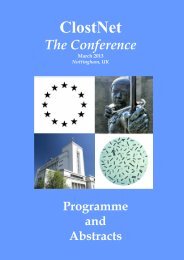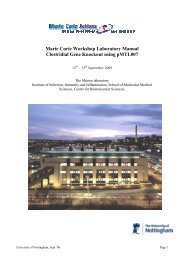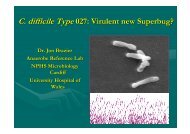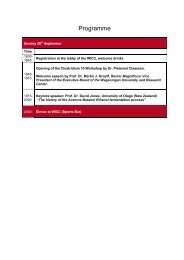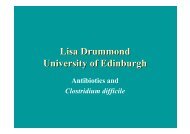abstract book - Clostridia
abstract book - Clostridia
abstract book - Clostridia
You also want an ePaper? Increase the reach of your titles
YUMPU automatically turns print PDFs into web optimized ePapers that Google loves.
INCREASING INCIDENCE OF BOTULISM IN CATTLE IN FLANDERS<br />
B. Pardon 1 , P. Deprez 1<br />
1 Department of Large Animal Internal Medicine, Faculty of Veterinary<br />
Medicine, Ghent University, Salisburylaan 133, B-9820 Merelbeke, Belgium<br />
Since 2003 an increasing incidence of botulism herd outbreaks has been<br />
reported in several European countries (e.g. England, Wales and Ireland).<br />
Botulism in cattle is caused by neurotoxins produced by Clostridium<br />
botulinum type B, C or D. Type C and D are poultry associated and most<br />
common in Europe. Type B is associated with forage. In the period 2001-<br />
2008 31 herd outbreaks of botulism were diagnosed at the faculty of<br />
Veterinary Medicine of Ghent University. The number of outbreaks rose<br />
spectacularly in 2003 and remained at a higher incidence up to 2008.<br />
Outbreaks affected both dairy and beef herds and occurred at pasture and<br />
in stabled animals. There was no seasonal distribution. Diagnosis was<br />
confirmed in 42% of the outbreaks by the mouse-toxin test. In 21% no<br />
diagnostic efforts were made. All outbreaks were type D, with one outbreak<br />
not being further determined. There were no outbreaks of the zoonotic type<br />
B. In total 59 samples were send to the reference lab for analysis. The<br />
percentage positive samples for liver and rumen fluid were respectively 29<br />
and 22%. No serum samples were positive. On 4 of the 6 most recent<br />
outbreaks, a poultry stable was present on the farm. Most other outbreaks<br />
were also poultry associated. Also the national animal health organisation<br />
(DGZ) reports an increase in possible outbreaks with 118 suspicions in<br />
2007-2008. Preventive measures in Belgium are limited to hygienic<br />
procedures and prevention of accidental spreading of carcasses in bovine<br />
feed or pastures. Vaccination is currently not allowed in Belgium.<br />
Treatment with anti-toxin is extremely expensive, not effective in all cases<br />
and needs type-identification. In general the possible risks for public health<br />
are thought to be minimal. In Belgium the precautionary principle is applied<br />
and preventive measures for public health are taken. In case of botulism<br />
suspicion milk delivery is forbidden until 17 days after the onset of the last<br />
clinical case. After conformation UHT-treatment or sterilisation is obligatory<br />
until 17 days after the last clinical case. The increasing European incidence<br />
of botulism in cattle, current public health policy and the lack of financial<br />
support for affected farms are strong arguments to enhance vaccine<br />
registration in Europe.<br />
47



